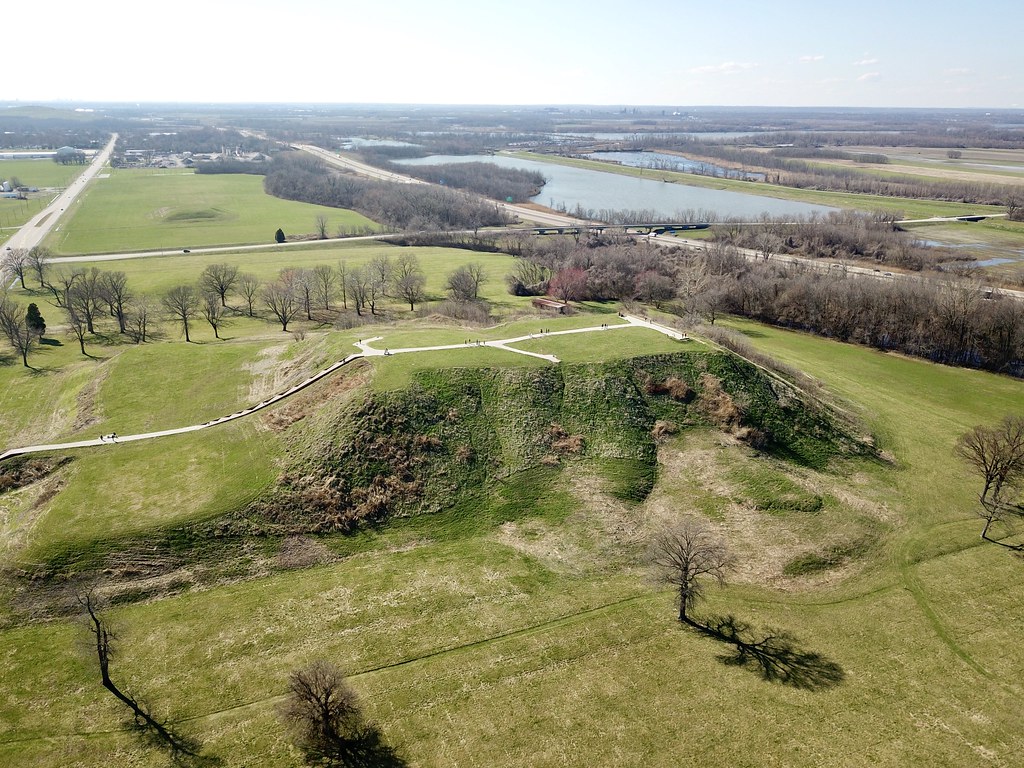
Cahokia NAGPRA Project
Background
The Cahokia Mound Center (11S34, 11MS4) is the largest pre-contact archaeological site in North America, dating to approximately AD 900-1300, and is located in Madison and St. Clair Counties near East St. Louis, Illinois. The Cahokia Mounds landscape encompassed over 2200 acres of land that incorporated multiple community plazas bordered by
~100 precontact burial, civic, and ceremonial mounds. This includes the largest earthwork in North America, Monks Mound, which stands at a height of 100 feet. Cahokia’s population at the height of its influence is estimated to have been between 10,000-20,000 people living in a complex society composed of a mix of local and non-local communities. Additional large mound centers in the American Bottom region surrounding Cahokia (the East St. Louis Precinct, St. Louis Precinct, Mitchell Mound Center, and Pulcher site) represent local ceremonial and political centers that were allied with the Cahokia community. Scattered between these mound centers in the uplands and floodplain of the American Bottom were thousands of individual hamlets, villages, and smaller civic and ceremonial centers that serviced rural communities. Also present at Cahokia is a much later post-contact occupation of the site by Jesuit missionaries in the late 16th-17th century. Historic burials, both Indigenous and non-Indigenous, were identified during several archaeological excavations in the 20th century.
The prominence of Cahokia in archaeological interpretations of the past resulted in additional investigations conducted by other institutions, including the Illinois State Museum, Southern Illinois University-Edwardsville, Washington University, the Milwaukee Public Museum, University of Wisconsin-Milwaukee, the Thomas Gilcrease Foundation, University of Michigan, University of Chicago, the University of Illinois at Chicago Circle, the Illinois Department of Conservation, and the Cahokia Mounds Museum Society. A consequence of the widespread interest in Cahokia investigations was the often-undocumented transfer of Cahokia cultural materials and ancestral remains between institutions for research purposes. This project has so far involved a large consultation event that brought together tribal nations interested in consulting on Cahokia and multiple institutions which curate NAGPRA-eligible archaeological collections from this site. The meeting focused on determining tribally-driven strategies for the repatriation and/or disposition of human remains and associated funerary objects from Cahokia. During the planning and follow-up stages of this project, documentation of human remains and associated funerary objects from Cahokia that are housed at the various institutions are being completed and finalized by project partners.
Information for Tribal Representatives
If you represent a tribal nation that has ties to the Cahokia site and would like to be involved in the NAGPRA process, please contact UIUC NAGPRA Program Officer Krystiana Krupa directly at klkrupa@illinois.edu.
Information for Collecting Institutions
As part of initial consultation meetings, our tribal partners for this project requested that we gather as much information as possible about the various collections from the Cahokia site. This specifically includes non-NAGPRA collections or those that institutions have not identified as falling under NAGPRA. The tribal nations involved in this project are interested in partnering with collecting institutions to review collections excavated from Cahokia in order to assess their cultural significance to these communities. We hope to synthesize as comprehensive an understanding as possible of the numerous collections from Cahokia spread across the country.
If you are part of a collecting institution that houses materials from Cahokia – whether or not they are known to fall under NAGPRA – and are interested in partnering with us on this project, please contact nagpra@illinois.edu or email UIUC NAGPRA Program Officer Krystiana Krupa directly at klkrupa@illinois.edu.